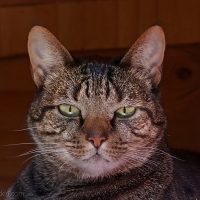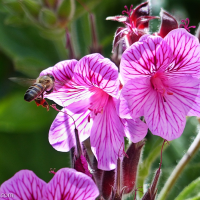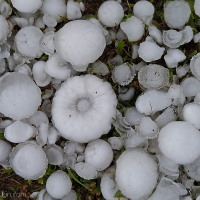I thought I’d share some interesting wildlife interactions between and within species that caught my eye (and camera) on our recent visit to the iMfolozi section of the Hlulhuwe-iMfolozi Park in Zululand. Although the focus of this blog is letting nature back into suburbia, you might like to share in this recent trip that let suburbanite me back into nature in a less domesticated context.
Associations between wild animals include companionship, parental care of offspring, competition, greetings and play, the hunter and the hunted, not forgetting interactions also with humanity.

Apparently good companions, these two giraffe in a dispersed group of several animals foraged together in close proximity

This mother warthog suckling her four piglets (two on each side) has to remain especially vigilant in the apparent absence of any assistance from another adult or sub-adult. Associated female warthogs may live in a small group of related individuals and such mothers may even suckle one another’s young. Adult males only join a female group when an adult female is in heat.

Also protecting her young is this beautiful crested francolin. One of the chicks can just be seen in the photo. Usually both parents participate in raising their young.

Following the leader – an adult female elephant crosses the fast flowing Black iMfolozi River followed by two youngsters, late one afternoon. There were other elephant in the vicinity, but we did not see any others crossing the river at this time.

Two sparring male impala in a bachelor herd, perhaps preparing for the autumn rutting season. They stood facing each other with much posturing and head lowering but did not make much contact in what was more a display of dominance than an actual contest.

Sparring between male elephants is also a common activity. These two elephants are quite evenly matched and their sparring consisted of confronting each other with heads held high, followed by trunk wrestling and much pushing and shoving.

The contest between them was very focused and intense, although they did break off a few times to browse the bushes for short periods while remaining close to each other.

Although similar in size, one of the elephants knelt momentarily while keeping his forelegs straight before launching into shoving his rival yet again.

Towards the end of the contest the pushing was more intense but we had a sense that the elephants were rather enjoying testing their strength and skills.

And suddenly it was all over as if by mutual consent. The encounter lasted over 15 minutes and then the mood changed and the pair moved off amicably together into the trees, transforming from rivals back into friends.

Nearby, an African monarch butterfly was enjoying its own encounter with a flowering Dwarf Boer-bean (Schotia capitata).

From its vantage point in a dead tree something moving on the ground caught its eye, and this steppe buzzard suddenly descended to search unsuccessfully for its elusive prey.

Browsing on its own this very large bull elephant, letting us know he was well aware of us, interacted calmly with us tourists as we sat watching from our vehicle. So as not to disturb him unduly, we kept at what we thought was a respectful distance.

White-fronted bee-eaters share a perch while keeping a sharp-eyed lookout for flying insects; their sub-adult status is revealed by the usually bright red patch below the white throat being washed-out and pale. And yes, white-fronted bee-eaters do eat bees (among other insects). The sharp narrow bills enable them to catch bees without getting stung. Once back at the perch they rub off the sting and its poison before swallowing the bee. White-fronted bee-eaters are gregarious and roost and nest communally. Related non-breeding birds often act as helpers, assisting the breeding pair with excavating the nest burrow and with feeding and raising the young.

A mother chacma baboon with her young baby together with sub-adults who are resting between bouts of playing; photographed on a patch of lawn near the gate inside the entrance to the Imfolozi section of the park.

A small group of baboons and a bachelor herd of impala foraged together on a sandy ridge above the river. The impala ate grasses and the baboons picked and stripped long twigs from low-growing shrubs.
 Buffalo and white rhino share a sandbank for some gentle sunbathing by the river on an overcast morning.
Buffalo and white rhino share a sandbank for some gentle sunbathing by the river on an overcast morning.

Three African wild dogs (one with a radio collar for monitoring purposes) associate with white rhino as the dogs try to work out how to cross the river that is abnormally full and flowing strongly. After investigating at various points on the bank, the dogs gave up crossing the river and returned into the bush.

A white rhino mother with her calf. In a further association, a Red-billed Oxpecker searches the mother’s back for ticks. These days I always feel fearful when I see a rhino with a young baby because so many rhino, even in well-protected areas, are poached for their horns, and many babies too have been killed or left traumatised and orphaned.

We came across this dehorned carcass of a rhino – a graphic reminder of humans’ all too brutal association with rhinos. We do not know if this rhino was poached or died of natural causes with the park staff removing the horn after death. Sadly, rhino poaching has taken place even in the Hluhluwe-iMfolozi Park, which is renowned for Operation Rhino that took place in 1950s and saved the white rhino from likely extinction. In the last decade anti-poaching activities have been stepped up as rhino poaching escalated dramatically in both small and large protected areas, including also the Kruger National Park. In some parks rhinos are humanely regularly dehorned (the horn grows back) in an effort to save them from poachers. In the decade 2007 to 2017 the recorded number of rhinos poached in South Africa is 7245. For more information on efforts to save rhinos see for example https://www.savetherhino.org/get-involved/

Waterholes provide opportunities for tourists to view interesting encounters between wild animals. With most of the natural waterholes and wallows being completely dry during our visit, the Bhejane Hide at iMfolozi with its pumped supply of water was busy with many visitors including numerous Burchell’s zebra, which were constantly coming and going in small groups, with ritualized greetings between individuals reminding me of elephant greeting behaviour I have witnessed rather than anything I had seen in zebras before.

During all the restless comings and goings at the waterhole, there were frequent squabbles between zebras that involved shoving, kicking, teeth baring and biting, and other challenges. Other visitors to the waterhole, including warthogs, seemed to regard all this hyper zebra activity with equanimity.

Several of the altercations that broke out resulted in rather dramatic chases, sometimes through the water, with much splashing, snorting and thundering of hooves. For more on zebra behaviour, society and their ecological role see https://animaldiversity.org/accounts/Equus_burchellii/

And lastly, the most notable iMfolozi interaction, sadly, is the development of opencast coal mining near the iMfolozi Wilderness area, which is impacting not only on the Hlulhuwe-iMfolozi Park but also on the lives, livelihoods and health of people, many of whom have been relocated, living in proximity to the mine. Above is a photo snapped from our car window of the Somkhele open cast coal mine operated by Tendele Mining Ltd since 2007. Community and environmental organisations are campaigning against the mine and the proposed Fuleni Mine, which will affect even more people and operate right against the border of the park’s Wilderness area.

Leaving the Hlulhuwe-iMfolozi Park only to drive past the huge mine was disheartening to say the least. The mine operates 24 hours a day and impacts include the extraction of water in a water-scarce region, pollution of water, dust and air pollution that impacts on people and their livestock, noise from machinery and blasting, light pollution at night, vibrations and cracks and damage to buildings from blasting.
For a documentary on the mining and its potentially harmful effects on people and animals see https://saveourwilderness.org/2018/11/05/5050-documentary-hluhluwe-imfolozi-threatened-by-mining/. For more information on the mining, its impacts, and campaigns to halt further mining see the following links:
https://www.groundup.org.za/article/activists-lose-bid-stop-coal-mine/
https://mg.co.za/article/2018-11-23-00-mine-fight-goes-on-despite-ruling
https://ejatlas.org/conflict/tendele-coal-mine-somkhele-kwazulu-natal
https://saveourwilderness.org/about/fuleni-community/
The last animal we saw as we drove out of the gates of the Hluhluwe-iMfolozi Park was this female baboon. Reading now about the mining operations taking place within sight, sound and smell of the park, I fully understand that she was right to regard me, a representative human, with such guarded wariness.
Sources: Colvin, L. and C. Nihranz 2009. ‘Equus burchelli’ (On-line), Animal Diversity Web. https://animaldiversity.org/accounts/Equus_burchellii/; Estes, Richard. 1993. The Safari Companion a Guide to Watching African Mammals. Halfway House: Russel Friedman; O’Connell-Rodwell, Caitlin. 2010. How Male Elephants Bond. Smithsonian Magazine. https://www.smithsonianmag.com/science-nature/how-male-elephants-bond-64316480/; Roberts VII Multimedia PC Edition. 1997-2016 Southern African Birding. For details go to http://www.sabirding.co.za/roberts7/portal.html; Save our iMfolozi Wilderness. https://saveourwilderness.org/; Save the rhino. https://www.savetherhino.org/
Posted by Carol










February 18, 2019 at 2:41 pm
What an interesting and informative theme you have chosen. I have enjoyed the read.
LikeLiked by 1 person
February 20, 2019 at 6:58 pm
Thanks very much Anne.
LikeLike
February 16, 2019 at 6:31 am
Sad, but not surprising, that the mine is right next door to the park. We are not as smart as we like to think we are. There are days (many days) when I think the best thing for the Earth might be something coming along that takes out the human race. But the photos are wonderful and seeing those elephants is very uplifting.
LikeLiked by 1 person
February 16, 2019 at 8:12 pm
And worse, there are rich deposits of coal within the park’s borders, which likely makes its long-term future uncertain. Its very easy to feel bleak. I suppose we need to balance realistic anxieties with living also in the moment and counting our blessings so to speak. Perhaps we can learn from those young elephants’ apparent zest for life.
LikeLiked by 1 person
February 18, 2019 at 5:30 am
The elephants are an inspiration, that’s for sure. The coal barons, not so much.
LikeLiked by 1 person
February 16, 2019 at 12:33 am
What a thrill to watch these animals in a natural setting. It’s a criminal shame that we can’t learn to co-exist. I’d best quit before I launch into a rant. Thank you so much for sharing these gentle views into their lives.
LikeLiked by 1 person
February 16, 2019 at 7:51 pm
Thanks Gunta. It is fantastic to be able to have a window into the lives of these wild animals and their everyday interactions. Not something to ever take for granted …
LikeLike
February 15, 2019 at 7:56 pm
Beautifully photographed and informative post. Disheartening to hear of the mining and so close to this reserve.
LikeLiked by 1 person
February 16, 2019 at 5:49 am
Thank you Belinda. Yes it is extremely disheartening.
LikeLiked by 1 person
February 15, 2019 at 2:31 pm
Wonderful shots, Carol, and much food for thought.
LikeLiked by 2 people
February 16, 2019 at 5:45 am
Thanks Sandra. It is sobering that visiting conservation areas is often more confronting than might be expected. Rather than providing a great escape I find that such visits foreground all kinds of problematic issues.
LikeLiked by 1 person
February 15, 2019 at 11:56 am
Once again very dramatic pictures Carol. We plan to go to St Lucia in July/August and will also be visiting the Hluhluwe-iMfolozi Park. Thanks for sharing
LikeLiked by 1 person
February 15, 2019 at 12:37 pm
Thanks Suzette. Enjoy your planning for your holiday. Depending on where you stay at St Lucia and if you are self-catering, check if you need to take drinking water with you!
LikeLike
February 15, 2019 at 7:02 am
Carol as always such a beauty-filled blog. I really appreciate that you included links to the strong activism in place that is trying to halt the devasting process. I agree, we need to respect and care for all our life on earth, flora and fauna, of which we are part of. xxx
LikeLiked by 1 person
February 15, 2019 at 11:33 am
Thank you Christeen. Yes you are right, we tend to think we are better or apart, when in fact we are part of and dependent upon the entire web of life.
LikeLike
February 15, 2019 at 6:52 am
Such a wonderful place for meeting the wild. The picture “Following the leader” shows the great expanse of the country.
LikeLiked by 1 person
February 15, 2019 at 11:31 am
It is a wonderful place. I must remember to include some more wide shots in the future!
LikeLiked by 1 person
February 15, 2019 at 1:39 am
Looks like you had a wonderful time at Hluhluwe-Imfolozi Park, Carol, and you came home with some absolutely beautiful shots!
Sad to think that such a special place is being threatened by our own kind…
LikeLiked by 1 person
February 15, 2019 at 5:45 am
Thanks so much. We did have an interesting time. It was worrying to see the waterholes so dry but hopefully the region will have late summer rain. Yes, the nearby open cast mining and associated activities and future plans are devastating.
LikeLiked by 1 person
February 14, 2019 at 9:10 pm
You’re either incredibly lucky or incredibly patient – I suspect the latter – to get these wonderfully immersive photos of life in the Park. So sad that your piece had to end on such a negative note. Like the fracking that’s beginning to take place in the UK, the desire to make a quick buck seems to override the needs of the landscape, its wildlife and the local inhabitants.
LikeLiked by 1 person
February 15, 2019 at 5:38 am
Thank you Margaret for your nice comment – a lot of luck is involved as so many factors have to come together. We must blithely drive past far more than we ever see! Sorry to mention the mining devastation but it is impossible to ignore. Fracking is a constant threat in parts of SA too, even though we are a water-scarce region.
LikeLiked by 1 person
February 14, 2019 at 8:58 pm
Wonderful photos of the wildlife…sometimes in my dreams I fear they do not exist anymore, especially the rhinos. We read and hear of so many killed – there is a constant heartache for nature and every living being. If only people would strive to understand that we all belong here and that we all are connected and dependent on each other. Thank you for posting.
LikeLiked by 2 people
February 15, 2019 at 5:26 am
Thank you Leya. I share your heartache and concern. So much trouble in the world. I do believe that a little respect goes a long way but we all tend to live in our bubbles if we can. And it’s hard to respect those with power whom we fear.
LikeLike
February 15, 2019 at 8:57 pm
So true.
LikeLiked by 1 person
February 14, 2019 at 8:13 pm
Beautiful images, Carol. I wish animals were viewed as equal to humans – they have a right to live, just as humans do. In considering them, we’d come out ahead.
LikeLiked by 2 people
February 15, 2019 at 5:18 am
Thank you Eliza. Yes animals are often completely discounted. And I wish that all humans were viewed with equal respect too. Perhaps respecting the rights of others, humans and animals, go hand in hand and might even lead to less of an us and them perspective.
LikeLiked by 2 people